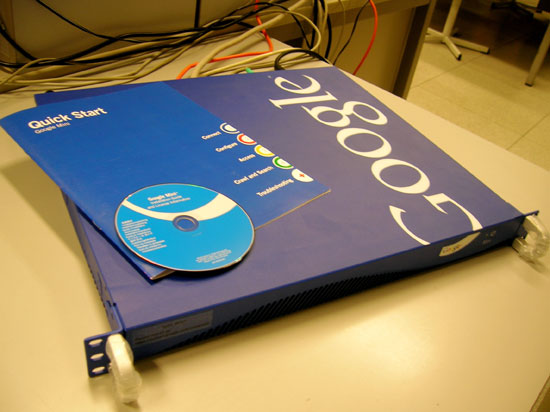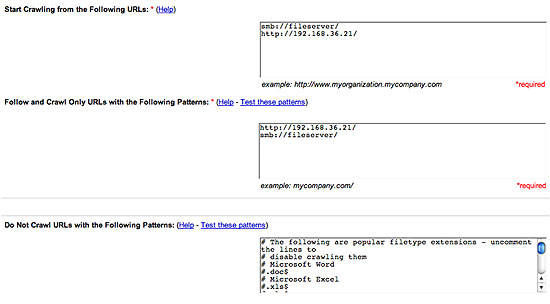The Google Mini - A look at Google's entry-level search appliance
by Liz van Dijk on December 21, 2007 12:00 AM EST- Posted in
- IT Computing
Scratching the surface
To provide hands-on experience, Google sent us a brand-new Mini with a license for 50,000 documents. As expected, we received a very complete package, including everything we needed to get our Mini up and running quickly, with minimal fiddling. Naturally, we wanted to take a peek at the Mini's insides, but Google is still not very keen on people trying to break into their systems. As we found in our prior review of the Mini, the case itself is solidly built, with exotic-looking tamper-resistant fasteners, and a large piece of plastic covers the top of the enclosure from front to rear, to inhibit removal .

The current Mini is half its former size, and was delivered with everything we needed to get started.
The Mini's internals reveal that Google has made some changes since AnandTech's last look. The machine's current specs are as follows:
- Supermicro motherboard (P8SCT)
- Two 1GB modules of PC4200 DDR2 RAM, running at 533MHz
- A single 250GB Western Digital SATA2 Hard Drive
- A 280 Watt PSU
- A 3GHz Pentium 4 531 (Prescott core)
We questioned whether this hardware was the best choice for a search appliance, a point we touch on later on in the article.

A closer look at what makes the Mini tick.
Unfortunately, our journey of discovery didn't take us beyond the hardware itself. Booting up the Mini, we were greeted with the bootup procedure of Red Hat Linux, which ended at a fitting blue login screen, leaving us completely locked out of the mysteries of what makes Google tick. Google understandably guards its technology carefully from prying eyes.
As before, when installing the Mini, the administrator connects the provided crossover cable to the Mini's admin port to perform initial configuration. This stage of setup is very simple; just assign the Mini a static IP address on the network it'll be crawling, and configure other general network settings. These steps require no special knowledge, since the provided Quick Start guide explains them very nicely. After completing these installation steps, the Mini's administration console is available over the network using a web browser for further configuration. Setting up the Mini's crawler was as simple as giving it some addresses to start from, and adding URL patterns to include and to avoid. For example, if we wished our Google Mini to crawl two separate webservers and a fileserver, we would give the Mini a hyperlink to the websites, and a samba-link (smb://) to the fileserver, and the crawler would get to work.
 Some links to the websites are all that is needed for the Mini to get started. |
Starting the Mini's actual crawl is as simple as that, but there are many options to provide detailed control. In our case, we let the Mini crawl some of the websites running at our lab, but found that we met the 50,000 page limit in a matter of hours, so we mainly settled for samba crawling in most of our tests.










19 Comments
View All Comments
Genx87 - Thursday, December 27, 2007 - link
The lack of security takes this out of an serious contention for a small or medium size business who can afford this device. The cost takes it out of the contention for business's who are small enough to not care about security as much.Having worked for a small business ~30 people. There is no way they would authorize me to spend that kind of cash on a device that indexes our documents. At my current employer which is ~200 people we would have the budget, but the lack of security will put the smackdown on it.
bfoster68 - Tuesday, December 25, 2007 - link
just to clear something up. You don't implement a raided solution as a form of backup. You implement it for fault tolerance so that if a drive fails your system stays up. I don't know what market segment google planned for this appliance but my company would require a fault tolerance solution providing 4 9's uptime.my guess is this appliance is for the small business segment and the hardware was designed with this in mind.
Any solution for a fortune 500 company would require at a minimum dual redundant power supplies and a hardware based, hot swapable raid configuration, Error corrrecting ram and many other features.
I am not very familiar with this product so please feel free to correct any inaccuracies.
Just my two cents.
Bill
dblevitan - Friday, December 21, 2007 - link
Has anyone tried taking out the hard drive, connecting it to another computer, and looking at what's on it? I'm sure it can't be too hard to see what's actually running on the computer.n0nsense - Sunday, December 23, 2007 - link
You'll probably find Linux based system inside running MySQL and the engine :)For the rest, the prescot CPU and 1 HD used because they cost less.
When you save 100$ on each box, it is 100,000$ for 1000 boxes :)
Lizz - Saturday, December 22, 2007 - link
Getting inside the Mini is probably not impossible, and we considered quite a bunch of methods, simply out of curiosity.However, the focus of this review is to give our readers a look at what the Mini actually offers those interested in purchasing one, so we decided not to give it too much focus. :)
drothgery - Friday, December 21, 2007 - link
At least on my employer's Google mini, I found that I could add cookies to the request header.andyleung - Friday, December 21, 2007 - link
For green purpose, maybe google will do the magic of using AMD Geode or VIA CPU that consumes no more than 5W of power in peak time and still process 250 queries per second. Good job google, I am looking forward to seeing you doing this one day.Taft12 - Friday, December 21, 2007 - link
Agreed, especially given the light load required for this appliance's purpose. In the meantime, if they must use a chip single-core desktop chip, why not one of the Core 2-based Celerons?Great review! I knew it would get bogged down in a hardware discussion though given the audience here.
PBMax - Friday, December 21, 2007 - link
This device is an appliance. It is not a "computer" in the traditional sense of a multipurpose server. I had to fight that idea when my previous company went into the appliance business. When you buy an appliance you buy what it can do and not how it does it. They sell these systems as 50,000 document and 300,000 document systems. So that is the benchmark for performance. As for RAID. This is an entry level system and as such is stripped down. I'm sure the higher end models support RAID. I went to a Google Enterprise seminar and they were talking about search appliances from the Mini to the OneBox and prices ranged from $1500 to over a million. Also I don't think the sysadmin has access to the machine at a level that they can backup anything but the settings. But since this is a search appliance they should be able to restore the box and import their settings and have it reindex their network.HotdogIT - Friday, December 21, 2007 - link
"In closing, we'd like to thank Peter Griffin of Google, who helped us out a great deal while exploring the Mini's features."Peter. Griffin.
Winnar!